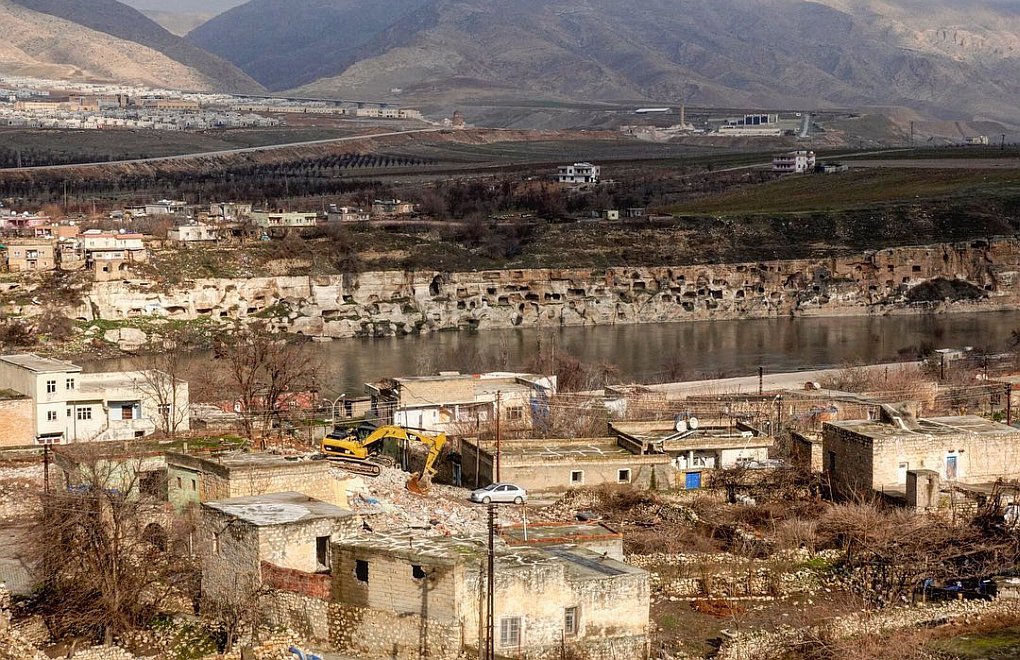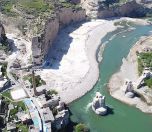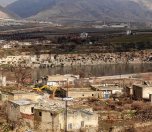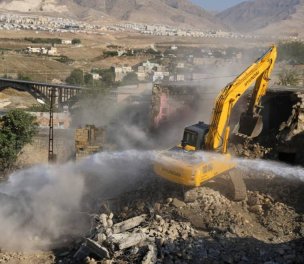* Photo: Hasankeyf Coordination
Click to read the article in Turkish
Hasankeyf Coordination has visited the villages of Hasankeyf, which is soon to be engulfed by the Ilısu dam as its reservoir keeps growing.
Making a statement for the press, the Coordination has announced that while 40 villages have been entirely flooded, a large part of houses and agricultural fields in 60 villages have been submerged by the rising water.
As reported by Yunus Emre Ceren from daily BirGün, Master Architect Mücella Yapısı has read out the statement on behalf of the coordination.
Mücella Yapıcı has said, "As a result of wrong policies, the city of Hasankeyf with at least 12 thousand years of history as well as 289 mounds and 199 villages and hamlets are engulfed, 80 of them entirely. The deluge and plunder continue along the Tigris Valley. A living being, a house, a history is submerged every second."
'Arguments come to nothing'
Yapıcı has briefly stated the following:
"In the Ancient City of Hasankeyf, historic areas were dynamited, heavy machinery was used in archeological excavation sites and cultural heritage was concreted. The arguments put forward by the government about the construction of this dam are coming to nothing with each passing day.
"Forced migration and the ensuing impoverishment are becoming visible wherever the dam reservoir has reached in both Hasankeyf and city center of Batman. We shouldn't be deceived by the display of large landowners.
'People are forced to poverty'
"The ratio of rich and poor across the country manifests itself here as well. At least 10 thousand people without any land have been and are still deprived of their right to housing, the most basic human right, without receiving any compensation. Unable to leave their villages, fearing that their houses will be submerged when they wake up in the morning, thousands of people are trying to sustain their lives under difficult conditions.
"In several villages, houses have been partly submerged and life goes on at their upper parts. The promises made for housing have not been kept.
'The extent of ecological destruction unknown'
"With the closing of the dam gates, millions of species have drowned in the waters of Tigris, which is a source of life. The dam reservoir has turned into a deluge along the valley. Even though it was said that new nesting sites would be formed for endangered species as a result of public outcry, there is no work in sight along the area, apart from a few towers for birds."
Artists make a call for Hasankeyf
Turkish Medical Association (TTB) member Dr. Nazmi Algan has read out the artists' joint call for Hasankeyf. Here is the statement signed by 94 artists including Ahmet Ümit, Altan Erkekli, Jehan Barbur, Levent Üzümcü, Metin Uca, Cengiz Bozkurt, Deniz Çakır, Onur Akın, Ercan Kesal, Fırat Tanış, Genco Erkal, Suavi and Zülfü Livaneli:
"Open the Dam Gates in a Controlled Manner, Put This Historic Mistake Right in Hasankeyf!
"One of the most valuable cultural heritage sites of the world where life has been uninterruptedly going on for 12 thousand years, the Ancient City of Hasankeyf is about to breathe its last! We want to warn you, the responsible parties, for the last time about Hasankeyf, which will be completely submerged if no intervention is made now.
"Let's not destroy such a value of ours for a dam project which cannot be explained with any rational need or reason and is deprived of any function. We, as the artists, intellectuals and writers of this country, are calling out to you, the responsible ones! We want the dam gates to be opened in a controlled manner in the region where the filling of water has started and we want the filled water to be emptied so that Hasankeyf can be kept alive. Let us put this historic mistake right together! Let us keep Hasankeyf alive!"
The statement has been signed by the following people: A.Mücella Yapıcı, Ahmet Ümit, Ali Bilge, Ali Uçansu, Altan Erkekli, Aydın Engin, Ayfer Düzdaş, Ayşe Cemal, Ayşe Erzan, Ayşegül Devecioğlu, Barış Atay, Barış Bağcı, Betül Arım, Beyza Üstün, Birce Akalay, Binnaz Toprak, Can Atalay, Celal Yıldırım, Celil Nalçakan, Cemil Qoçgiri, Cengiz Bozkurt, Cezmi Baskın, Damla Kılıçoğlu, Deniz Çakır, Deniz Türkali, Diljen Roni, Doğan Bermek, Emine Uşaklıgil, Ercan Kesal, Erdoğan Aydın, Erdoğan Kahyaoğlu, Erhan Güleryüz, Erol Babaoğlu, Esra Koç, Fırat Tanış, Genco Erkal, Gençay Gürsoy, Gülseren Onanç, Güney Zeki Göker, Gürhan Ertür, Hacer Ansal, Haluk Levent, Hüsnü Arkan, Iraz Yöntem, İrfan Değirmenci, Jehan Barbur, Kıraç, Levent İnanır, Levent Üzümcü, Mebuse Tekay, Melek Ulagay Taylan, Mem Ararat, Metin Uca, Mikail Aslan, Mustafa Paçal, Mustafa Peköz, Nakiye Boran, Nazar Büyüm, Nazım Dikbaş, Neslihan Yargıcı, Nesrin Nas, Nesteren Davutoğlu, Neşe Erdilek, Nevin Soyukaya, Nilüfer Açıkalın, Nurcan Baysal, Nurhan Özenen, Nurten Ertuğrul, Onur Akın, Orhan Alkaya, Orhan Aydın, Orhan Silier, Oya Baydar, Özgür Mumcu, Rıza Akın, Saygın Ersin, Selim Temo, Sinan Tuzcu, Soner Olgun, Suavi, Şebnem Sönmez, Şevval Sam, Tarık Günersel, Tatyos Bebek, Ülkü Duru, Viki Çiprut, Yasemin Bektaş, Yavuz Ekinci, Yekta Kopan, Zeynep Tanbay, Zülfü Livaneli |
About Ilısu Dam ProjectThe construction of Ilısu Dam was included in the Southeastern Anatolia Project (GAP), a state-sponsored regional development project continuing for decades, in 1982. After the project was included in the government's investment program in 1997, protests were staged both in Turkey and in European countries where the companies that financially support the project based. As a result, the project was stopped in 2002. When the Ilısu project came to the fore in 2005, the construction of the dam was tried to be prevented with a stronger campaign. As a result of this, the Initiative to Keep Hasankeyf Alive emerged. Hasankeyf and the Tigris Valley are still there as a result of the struggle of tens of civil society organizations who oppose the construction of the dam. But the process has become more difficult lately. In 2017, seven monuments were moved from Hasankeyf. Two monuments, one of them is the famous Tigris Bridge, were covered with rocks under the guise of 'restoration'. More than 200 caves that were dug in Neolithic Era pioneers and large parts of the valley next to the castle were filled with excavation waste. According to statements by authorities, dam gates will be closed and the dam will begin to fill with water. If the gates are closed, Hasankeyf will be totally submerged into water within four to eight months. Source: Hasankeyf Initiative |
(TP/SD)








